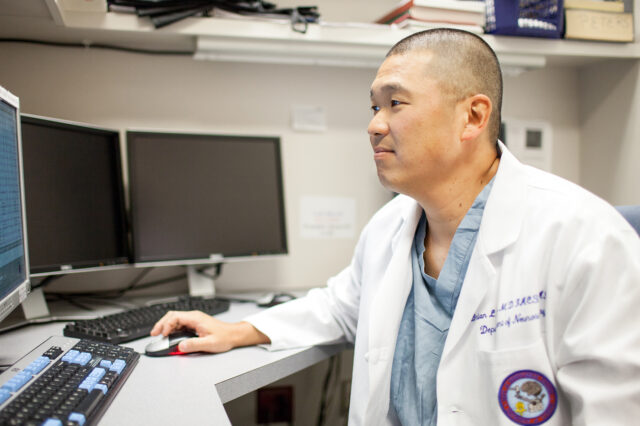C-sections might not be needed for pregnant women who have unruptured brain aneurysms

Cesarean sections are used almost three times as often to deliver the babies of women who have an unruptured brain aneurysm — a blood-filled ballooning of a blood vessel — as for other women. But that extra precaution might not be necessary, say researchers at the University of Florida.
That’s because the risk of an aneurysm rupturing during pregnancy or delivery is not any higher than for women who are not pregnant, the researchers found in a study published in the February issue of the journal Neurosurgery.
“If a pregnant woman gets an aneurysm, obstetricians are generally afraid to have the mother deliver vaginally because they worry that might cause the aneurysm to rupture,” said senior author Brian Hoh, M.D., the William Merz associate professor of neurological surgery, and a joint associate professor of radiology and of neuroscience in the UF College of Medicine. “I hope this analysis will help guide their management of the pregnant woman who has an unruptured cerebral aneurysm.”
Aneurysms form when blood vessel walls get too weak to withstand the pressure of blood pulsing through. Doctors aren’t clear about the exact causes, but rupture is often fatal.
Unruptured brain aneurysms affect about 3 percent of the general population, according to a 2011 analysis published in the journal Lancet. Women are at higher risk than men. Brain aneurysms are rare in pregnant women and doctors can’t predict when a rupture might occur. If a brain bleed happens, it often leads to the death of the fetus and of the mother. In fact, it is one the main non-childbirth-related causes of death among pregnant women.
The way to treat aneurysms is to prevent blood from flowing in. That’s done in either of two ways: using a tiny metal clip to grab the “neck” of the aneurysm, or using platinum coils to seal the opening.
To determine the risk of rupture among pregnant women, Hoh and co-authors Young Woo Kim, M.D., a neurosurgeon at The Catholic University of Korea, and Dan Neal, M.S., a UF biostatistician, analyzed 20 years’ worth of data from a national hospital discharge database.
They estimated the rate of unruptured aneurysms among women of childbearing age at 1.8 percent by comparing the rate of aneurysms among all women, known to be just under 4 percent, with the rate among women ages 16 to 44.
Based on more than 17 million hospitalizations involving deliveries, of which 218 involved unruptured aneurysms and 172 involved ruptured aneurysms, the researchers estimated the risk of delivery-related rupture at just 0.05 percent.
Despite these low risks, 70 percent of women with diagnosed unruptured aneurysms had precautionary C-sections, compared with just 25 percent of the general population of pregnant women having the procedure.
Women with aneurysms tended to be treated more often with clipping, the more traditional treatment method, than with coiling. The death rate among women hospitalized for pregnancy and who did not receive clipping or coiling was double that for those treated. And the death rate among untreated patients who had babies was more than triple that of patients who had been treated.
“Overall, this report adds to the literature suggesting that, although intracranial hemorrhage is an important cause of obstetrical morbidity and mortality, aneurysmal cases are rare, and, if they are more likely to occur during pregnancy and the puerperium (the period immediately following childbirth), then this increased risk is likely to be small,” wrote R. Loch MacDonald, M.D., Ph.D., head of neurosurgery at St Michael’s Hospital at the University of Toronto, in an editorial that accompanied the paper.